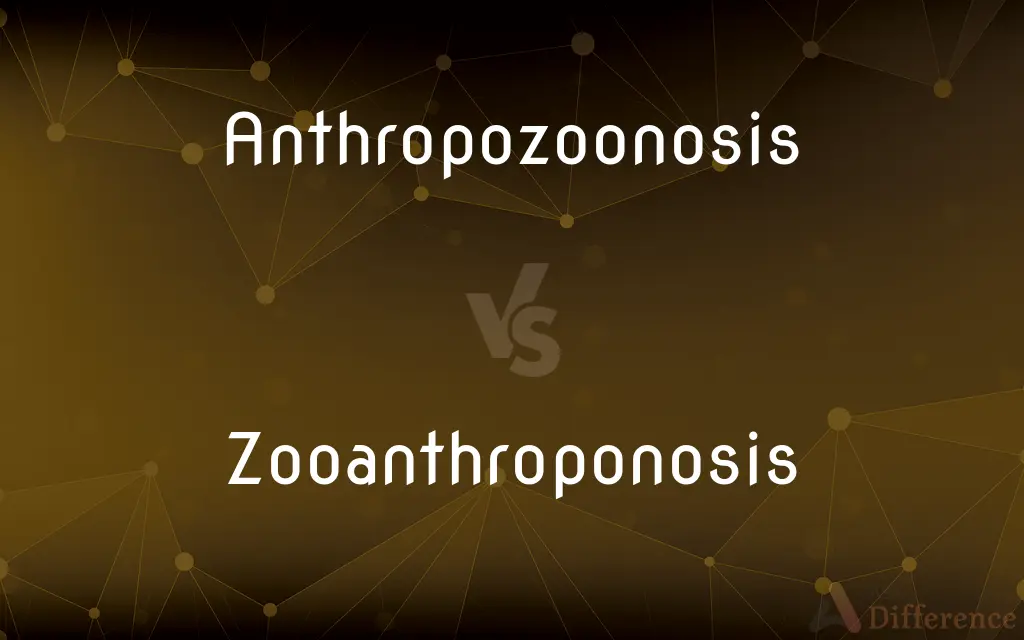Anthropozoonosis vs. Zooanthroponosis — What's the Difference?
By Maham Liaqat & Fiza Rafique — Updated on May 9, 2024
Anthropozoonosis refers to infectious diseases primarily transmitted from animals to humans (e.g., rabies), whereas zooanthroponosis describes diseases that are primarily transmitted from humans to animals (e.g., tuberculosis in captive wildlife).

Difference Between Anthropozoonosis and Zooanthroponosis
Table of Contents
ADVERTISEMENT
Key Differences
Anthropozoonosis describes diseases that originate in animals and can be transmitted to humans. Examples include rabies and avian influenza. Zooanthroponosis, on the other hand, refers to diseases that are primarily transmitted from humans to animals, such as tuberculosis infecting primates in zoos.
Anthropozoonosis affects humans through direct contact, consumption of contaminated food, or through vectors like mosquitoes. Zooanthroponosis often results from close contact with humans, where animals are exposed to human pathogens.
Anthropozoonosis often poses a risk to public health due to the potential for outbreaks or epidemics. Zooanthroponosis, while less known, can significantly impact animal populations, particularly in wildlife conservation and farming.
Anthropozoonosis requires animal-to-human contact for transmission. Zooanthroponosis needs humans to carry and pass the pathogen to susceptible animal species.
Anthropozoonosis is historically recognized because of its impact on human health. Zooanthroponosis is a more recent concept but is crucial in preventing reverse zoonotic transmission.
ADVERTISEMENT
Comparison Chart
Direction
Animal to human
Human to animal
Transmission
Through vectors, direct contact, food
Close contact, vectors
Impact
Public health, epidemics
Wildlife, conservation, farming
Examples
Rabies, avian influenza, Ebola
Tuberculosis, influenza, MRSA
Recognition
Historically well-known
More recent concept in research
Compare with Definitions
Anthropozoonosis
A zoonotic process that significantly affects public health.
Emerging anthropozoonoses like avian flu can cause global health concerns.
Zooanthroponosis
A reverse zoonotic process that can affect wildlife conservation.
Zooanthroponosis may threaten wild animal populations with unique susceptibilities.
Anthropozoonosis
An infection cycle involving wildlife, domesticated animals, and humans.
Bats can harbor viruses that cause anthropozoonosis in humans.
Zooanthroponosis
Transmission often involves close contact with infected humans or shared environments.
Zooanthroponosis can occur in zoos where animals and humans interact closely.
Anthropozoonosis
Transmission can occur directly, through vectors, or contaminated food.
The mosquito vector is responsible for the anthropozoonosis of West Nile virus.
Zooanthroponosis
An infection cycle that highlights the need for comprehensive health surveillance.
Veterinary staff monitor animals to detect zooanthroponotic infections.
Anthropozoonosis
Diseases that can lead to epidemics or pandemics due to animal-to-human transmission.
Ebola outbreaks are anthropozoonotic and can have devastating effects.
Zooanthroponosis
Diseases that can significantly affect farming or captive wildlife.
MRSA is a zooanthroponosis affecting livestock and pets.
Anthropozoonosis
Infectious diseases that primarily spread from animals to humans.
Rabies is a classic example of anthropozoonosis, commonly transmitted by dog bites.
Zooanthroponosis
Infectious diseases primarily transmitted from humans to animals.
Primates can catch zooanthroponotic tuberculosis from infected humans.
Anthropozoonosis
(pathology) Any pathogen that is transmitted from animals to humans. Specifically, it refers to infections that primarily affect animals but can be naturally transmitted to humans.
Examples of anthropozoonoses include brucellosis bacteria or rabies and Ebola viruses.
Zooanthroponosis
The transmission of disease from humans to animals. Specifically it refers to diseases that are primary infections of humans but which can be naturally transmitted to animals. Examples include tuberculosis and human metapneumovirus.
Common Curiosities
Are all zoonotic diseases considered anthropozoonotic?
No, only those transmitted from animals to humans specifically.
Can zooanthroponosis affect wildlife conservation?
Yes, wildlife exposed to human diseases can suffer significant population declines.
Is zooanthroponosis as common as anthropozoonosis?
It's less common but significant in settings where humans and animals interact closely.
Is there a difference between zoonosis and anthropozoonosis?
Yes, zoonosis broadly refers to any animal-human disease transmission, while anthropozoonosis specifically describes animal-to-human transmission.
Is zooanthroponosis primarily a veterinary concern?
It's significant in veterinary medicine but also crucial for wildlife conservationists.
Can humans transmit viruses to pets?
Yes, diseases like influenza can be passed to pets, which is a form of zooanthroponosis.
Is rabies a form of anthropozoonosis or zooanthroponosis?
Rabies is anthropozoonotic, as it's primarily transmitted from animals to humans.
What role do vectors play in anthropozoonosis?
Vectors like mosquitoes can transfer pathogens from infected animals to humans.
Can a disease be both anthropozoonotic and zooanthroponotic?
Yes, some diseases can travel in both directions, making control more challenging.
Can zooanthroponosis cause epidemics among animals?
Yes, if the disease is highly transmissible and affects vulnerable populations.
How do researchers prevent zooanthroponosis?
By monitoring human health, limiting animal-human contact, and improving hygiene practices.
Do anthropozoonoses only affect humans?
While humans are primarily affected, the disease origin can have implications for animal populations.
How can farmers prevent zooanthroponosis in livestock?
By ensuring workers are healthy, maintaining good hygiene, and monitoring for symptoms.
Can animals develop immunity to zooanthroponotic diseases?
Some animals may develop resistance, but many are highly susceptible.
Do both anthropozoonosis and zooanthroponosis require quarantine measures?
Yes, quarantining infected humans or animals can prevent further spread.
Share Your Discovery

Previous Comparison
Crystalized vs. Crystallized
Next Comparison
Refrain vs. ReframeAuthor Spotlight
Written by
Maham LiaqatCo-written by
Fiza RafiqueFiza Rafique is a skilled content writer at AskDifference.com, where she meticulously refines and enhances written pieces. Drawing from her vast editorial expertise, Fiza ensures clarity, accuracy, and precision in every article. Passionate about language, she continually seeks to elevate the quality of content for readers worldwide.
















































